HIGHER ORDER THINKING SKILL BASED QUESTIONS from S DINESH & CO CHEMISTRY (HINGLISH) PERIODIC CLASSIFICATION OF ELEMENTS for Class 10
| Class 10 | CHEMISTRY |
| Chapter | PERIODIC CLASSIFICATION OF ELEMENTS |
| S DINESH & CO CHEMISTRY (HINGLISH) | HIGHER ORDER THINKING SKILL BASED QUESTIONS |
| Medium | English |
| Academic Year | 2023-2024 |
Question 11
(a) Lithium, sodium, potassium are all metals that react with water to liberate hydrogen gas. Is there any similarity in the atoms of these elements?
(b) Helium is an unreactive gas and neon is a gas of extremely low reactivity. What, if anything, do their atoms have in common?View SolutionQuestion 16
Which element has
(a) two shells, both of which are completely filled with electrons?
(b) the electronic configuration 2, 8, 2?
(c) a total of three shells, with four electrons in its valence shell?
(d) a total of two shells, with three electrons in its valence shell?
(e) twice as many electrons in its second shell as in its first shell?View SolutionQuestion 19
The position of three elements A, B and C in che periodic table are shown below :
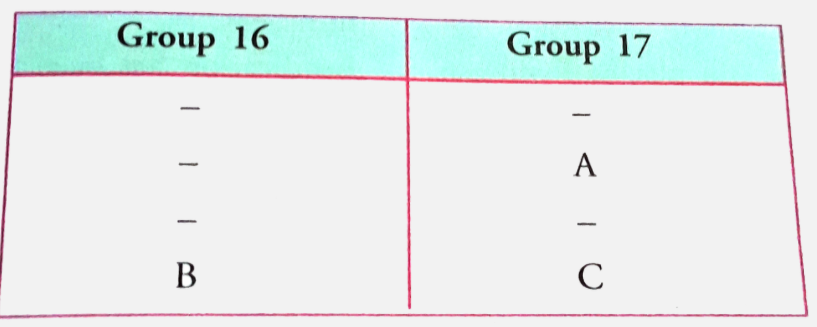
(a) State whether A is metal or non-metal.
(b) Seate whether C is more reactive or less reactive than A.
(c) Will C be larger or smaller in size than B ?
(d) Which type of ion, cation or anion will be formed by the element A ? View SolutionQuestion 57
Identify the elements from the following characteristics and arrange them in increasing order of metallic character.
(a) An element which imparts golden yellow colour to the flame.
(b) An element whose oxide is used as a white wash.
(c) An element which is constituent of of chlorophyll i.e. green colouring matter in plants. View SolutionQuestion 59
From the part of a periodic table, answer the following questions

(a) Atomic number of oxygen is 8. What would be the atomic number of, Fluorine ?
(b) Out of 'X' and 'Q' which element has larger atomic size ? Give reason for your answer.
(c) Out of 'Y' and 'Z' which element has smaller atomic size ? Give reason for your answer. View SolutionQuestion 65
(a) The elements of the second period along with their atomic numbers in parentheses are given below :
B (5), Be (4), O(8), N(7), Li (3), C (6), F (9)
(i) Arrange them in the same order as they appear in the periodic table.
(ii) Which element has the largest and smallest atom ?
(b) Why does atomic radius change as we move from left to right in a period ? View SolutionQuestion 71
Examine elements of the third period : Na, Mg, Al, Si, P, S, Cl, Ar and answer the following :
(a) Choose (i) Metals and (ii) Non-Metals out of these elements. (b) On which side of the periodic table can we locate (i) Metals and (ii) Non-Metals ?
(c) Name the Metalloid out of the elements given above. Where are they located in the periodic table ? View SolutionQuestion 72
Two elements M and N belong to group I and II respectively and are in the same period of the periodic table. How do following properties of M and N vary ?
(a) Size of their atoms (b) Their metallic character
(c) Their valencies in forming oxides (d) Formulae of their chlorides View SolutionQuestion 78
The following table shows the positions of six elements A, B, C, D, E and F in the modern periodic table

(i) Which element will form only covalent compounds ?
(ii) Which element is a metal with valency two ?
(iii) Out of D and E, which one has a bigger atomic radius ? Give reason for your answers.View SolutionQuestion 79
Given below are some elements of the modern periodic table :
4Be,9F,14Si,19K,20Ca
(i) Select the element that has one electron in the outermost shell and write its electronic configuration.
(ii) Select two elements that belong to the same group. Give reason for your answer.
(iii) Select two elements that belong to the same period. Which one of the two has bigger atomic size ? View SolutionQuestion 80
The elements Li, Na and K, each having one valence electron, are in period 2, 3 and 4 respectively of modern periodic table.
(a) In which group of the periodic table should they be ?
(b) Which one of them is least reactive ?
(c) Which one of them has the largest atomic radius ? Give reason to justify your answer in each case.View SolutionQuestion 89
An element 'X' belongs to 3rd period and group 16 of the Modern, Periodic Table.
(a) Determine the number of valence electrons and the valency of 'X'.
(b) Molecular formula of the compound when 'X' reacts with hydrogen and write its electron dot structure.
(c) Name the element 'X' and state whether it is metallic or non-metallic.View SolutionQuestion 90
Three elements 'X', 'Y' and 'Z' have atomic numbers 7, 8 and 9 respectively.
(a) State their positions (Group number and period number both) in the Modern Periodic Table.
(b) Arrange these elements in the decreasing order of their atomic radii.
(c) Write the formula of the compound formed when 'X' combines with 'Z'. View SolutionQuestion 91
An element 'X' belongs to 3rd period and group 13 of the Modern Periodic Table.
(a) Determine the valence electrons and the valency of 'X'.
(b) Molecular formula of the compound formed when 'X' reacts with an element 'Y' (atomic number = 8).
(c) Write the name and formula of the compound formed when 'X' combines with chlorine.View SolutionQuestion 93
Write the names given to the vertical columns and horizontal rows in the Modern Periodic Table. How does the metallic charcter of elements very on moving down a vertical column ? How does the size of atomic radius vary on moving left to right in a horizontal row ? Give reason in pupport of your answer in the above two cases.View SolutionQuestion 95
The atomic number of an element is 19.
(a) Write the electronic configuration of the element and determine (i) the valency of the element and (ii) whether the element is a metal or non-metal.
(b) Write the formula of the oxide of the element.
(c) Is the element more reactive or less reactive than Na (atomic number 11). Justify your answer giving example. View SolutionQuestion 97
Three elements A, B and C have atomic numbers 7, 8 and 9 respectively.
(a) What would be their positions in the modern periodic table ? (Mention group and period both)
(b) Arrange A, B and C in decreasing order of their size.
(c) Which one of the three elements is most reactive and why ?View SolutionQuestion 98
The elements with atomic number 3 to 10 belong to the second period. Taking into account the trends in the general periodic properties, predict.
(a) The most electronegative element
(b) The most electropositive element
(c) The element belonging to noble gas family
(d) The element which constitutes large number of organic compounds.
(e) The element most abundant in air View SolutionQuestion 100
The electronic configuration of three clements X, Y and Z are given below ,
X = 2 , Y = 2, 6 , Z = 2, 8, 2.
(i) Which element belongs to the second period ? (ii) Which element belongs to the eighteenth group ?
(iii) Which element belongs to the second group ? (iv) What is the valency of Y ?
(v) Are Y and Z metals or non-metals ?View SolutionQuestion 101
The atomic numbers of elements A, B, C, D and E are given below :

From the above table, answer the following questions -
(a) Which two elements are chemically similar ? (b) Which is an inert gas ?
(c) Which element belongs to 3rd period of periodic table ? (d) Which element among these is a non-metal ?View SolutionQuestion 103
The atomic radii of the elements of second period are given below:

(a) Arrange these elements in the decreasing order of their atomic radii (Keeping the element with the largest atomic radius first).
(b) Are the elements now arranged in the pattern of a period in the periodic table?
(c) Which elements have the largest and the smallest atoms?
(d) From this data, infer how the atomic size (or atomic radius) of the elements changes as you go from left to right in a period?View SolutionQuestion 104
'The atomic number of Cl is 17. On the basis of this information, answer the questions that follow :
(a) Write the electronic configuration of Cl.
(b) Find its valency.
(c) To which group does it belong ?
(d) Identify the type of ion it will form.
(e) Write down the formula of the compound it forms with other elements. View SolutionQuestion 105
The list of the elements present in the same period but in different groups is given :
12 13 14 15 16 17 18
(a) Do these groups represent modern periodic table ?
(b) Which element will belong to oxygen family ?
(c) Which element will not take part in chemical combination ?
(d) The elements belonging to which groups will form ionic bonds most readily ? View SolutionQuestion 106
An element E has following electronic configuration :
KLM286
(a) To which group of the periodic table does element E belong ?
(b) To which period of the periodic table does element E belong ?
(c) State the number of valence electrons present in element E.
(d) State the valency of the element E. View SolutionQuestion 107
From the part of the periodic table given, answer the following questions.

(a) Which is the most reactive metal ? (b) Name the family of L, Q, R, T.
(c) Name one element of group 2 and 15, (d) Name one member of group 18 other than neon. (e) Give the name of the element S placed below carbon in group 14. View SolutionQuestion 109
(a) How are the following related ?
(i) Number of valence electrons of the different elements present in the same group.
(ii) Number of the shells of the elements in the same period.
(b) How do the following change ?
(i) Number of shells of the elements as we go down a group.
(ii) Number of valence electrons of elements on moving from left to right in a period.
(iii)Atomic radius in moving from left to right along a period.
(iv) Atomic size down a group. View SolutionQuestion 110
The position of some elements A, B, C, D, E, F, and G in the Modern Periodic Table is given as under.
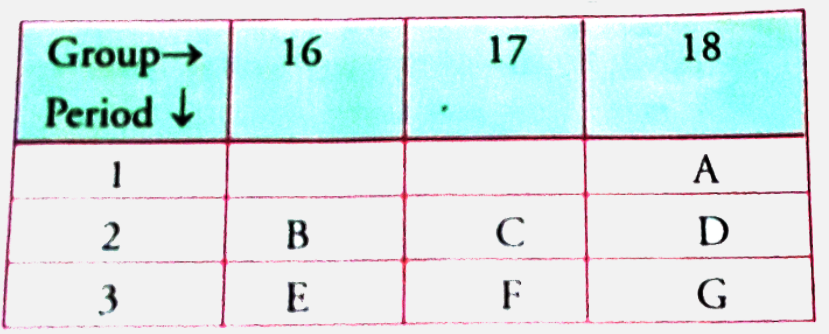
(a) In which group are inert elements placed ?
(b) What type of ions would B, C, E, and F form ?
(c) Which element would have chemical properties similar to C ?
(d) How many shells can A have ?
(e) What is the similarity between A and D ?
(f) Identify the most abundant element in the earth's crust.View SolutionQuestion 111
(a) The modern periodic table has been evolved through the early attempts of Dobereiner, Newland and Mendeleev. List one advantage and one limitation of all the three attempts.
(b) Name the scientist who first of all showed that atomic number of an element is a more fundamental property than its atomic mass.
State Modern periodic law. View SolutionQuestion 112
Atoms of eight elements A, B, C, D, E, F, G and H have the same number of electronic shells but different number of electrons in their outermost shell. It was found chat elements A and G combine to form an ionic compound. This compound is added in a small amount to almost all vegetable dishes during cooking Oxides of elements A and B are basic in nature while those of E and F are acidic. The oxide of D is almost neutral. Based on the above information answer the following questions :
(i) To which group or period of the periodic table do the listed elements belong ?
(ii) What would be the nature of compound formed by a combination of elements B and F ?
(iii) Which two elements could definitely be metals ?
(iv) Which one of the eight elements is most likely to be found in gaseous state at room temperature ?
(v) If the number of electrons in che outermost shell of elements C and G be 3 and 7 respectively, write the formula of rhe compound formed by the combination of C and G. View SolutionQuestion 113
The following table shows the position of six elements A, B, C, D, E and F in the period table.

Using the above table answer the following questions :
(a) Which element will form only covalent compounds ?
(b) Which element is a metal with valency 2 ?
(c) Which element is a non-metal with valency of 3 ?
(d) Out of D and E, which one has more atomic radius and why?
(e) Write a common name for the family of elements C and F. View SolutionQuestion 115
Atoms of seven elements A, B, C, D, E, F and G have a different number of electronic shells but have the same number of electrons in their outermost shells. The elements A and C combine with chlorine to form an acid and common salt respectively. The oxide of element A is liquid at room temperature and is a neutral substance while the oxides of the remaining six elements are basic in nature. Based on the above information, answer the following questions given ahead :
(i) What could the element A be ?
(ii) Will elements A to G belong to the same period or same group of the periodic table ?
(iii) Write the formula of the compound formed by the reaction of the element A with oxygen.
(iv) Show the formation of the compound by a combination of element C with chlorine with the help of electronic structure.
(v) What would be the ratio of number of combining atoms in a compound formed by the combination element A with carbon ?
(vi) Which one of the given elements is likely to have the smallest atomic radius ? View SolutionQuestion 135
The elements Li, Na and K, each having one valence electron, are in period 2, 3 and 4 respectively of modern periodic table.
(a) In which group of the periodic table should they be ?
(b) Which one of them is least reactive ?
(c) Which one of them has the largest atomic radius ? Give reason to justify your answer in each case.View SolutionQuestion 141
Two elements M and N belong to group I and II respectively and are in the same period of the periodic table. How do following properties of M and N vary ?
(a) Size of their atoms (b) Their metallic character
(c) Their valencies in forming oxides (d) Formulae of their chlorides View SolutionQuestion 145
Write the names given to the vertical columns and horizontal rows in the Modern Periodic Table. How does the metallic charcter of elements very on moving down a vertical column ? How does the size of atomic radius vary on moving left to right in a horizontal row ? Give reason in pupport of your answer in the above two cases.View SolutionQuestion 149
Which of the following statements (s) about the modern periodic table are incorrect ?
(i) The elements in the modern periodic table are arranged on the basis of their decreasing atomic numbers
(ii) The elements in the modern periodic table are arranged on the basis of their increasing atomic mases.
(iii) Isotopes are placed in adjoining group(s) in the periodic table
(iv) The elements in the modern periodic table are arranged on the basis of their increasing atomic number.View SolutionQuestion 185
Identify, the elements with the following property and arrange them in increasing order of their reactivity.
(a) An element which is a solt and reactive metal.
(b) The metal which is an important constituent of limestone
(c) The metal which exists in liquid state at room temperature.View SolutionQuestion 186
Properties of the elements are given below. Where would you locate the following elements in the periodic table ?
(a) A soft metal stored under kerosene
(b) An element with variable (more than one) valency stored under water.
(c) An element which is tetravalent and forms the basis of organic chemistry
(d) An element which is an inert gas with atomic number 2
(e) An element whose thin oxide layer is used to make other element corrosion resistant by the process of ''anodising''.View SolutionQuestion 187
An element is placed in 2nd group and 3rd period of the periodic table, burns is presence of xygen of form a basic oxide
(a) Identify the element
(b) Write the electronic configuration
(c) Write a balanced equation when it burns in the presence of air
(d) Write a balanced when this oxide is dissolved in water
(e) Draw the electron dot structure for the formation of this oxide.View SolutionQuestion 188
An element X (atomic number 17) reacts with an element Y (atomic number 20) to form a divalent halide
(a) Where in the periodic table are elements X and Y placed ?
(b) Classify X and Y as metal (s), non-metal (s) or metalloid (s)
(c) What will be the nature of oxide of element Y ? Identify the nature of bonding in the compound formed
(d) Draw the electron dot structure of the divalent halide.View SolutionQuestion 189
Atomic number of few elements are given below 10, 20, 7, 14
(a) Identify the elements
(b) Identify the group number of these elements in the periodic table
(c) Identify the periods of these elements in the periodic table
(d) What would be the electronic configuration for each of these elements
(e) Determine the valency of these elements.View SolutionQuestion 191
Complete the following crossword puzzle (Figure)
Across
(1) An element with atomic number 12
(3) Metal used in making cans and member of group 14
(4) A lustrous non-metal which has 7 electrons in its outermost shell
Down
(2) Highly reactive and soft metal which imparts yellow colour when subjected to flame and is kept in kerosene
(5) The first element of second period
(6) An element whihc is used in making flurescent bulbs and is second member of group 18 in the modern periodic table
(7) A radioactive element which is the last member of halogen family
(8) Metal which is an important constituent of steel and forms rust when exposed to moist air
(9) The first metalloid in modern periodic table whose fibres are used in making bullet-proof vests
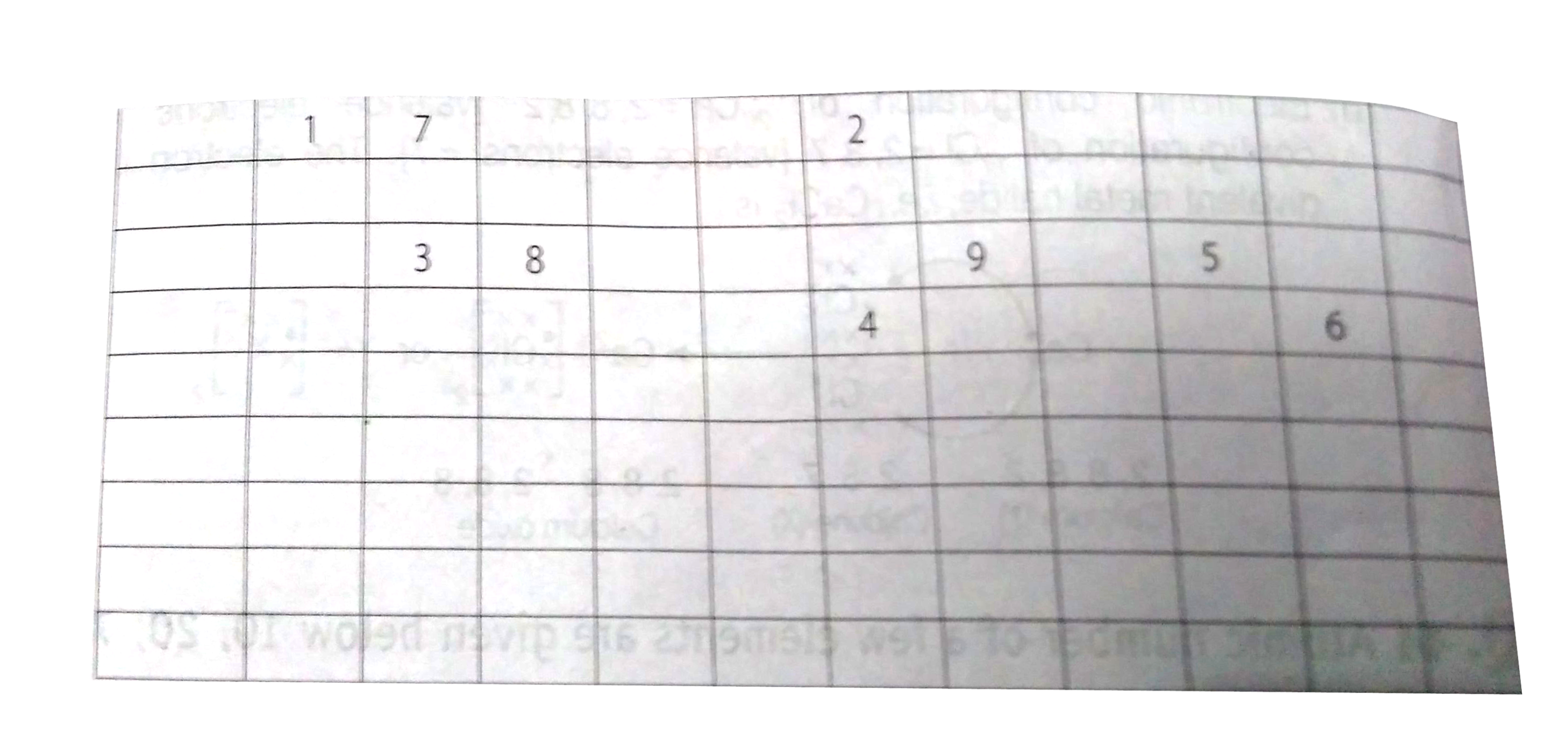 View Solution
View SolutionQuestion 192
Mendeleev predicted the existence of certain elements not known at that time and named two of them as Eka-Silicon and Eka-aluminium
(a) Name the elements which have taken the place of these elements
(b) Mention the group and the period of these electron in the modern periodic table
(c) Classify these elements as metals, non-metals or metalloids
(d) How many valence electrons are present in each one of them ?View SolutionQuestion 193
(a) Electropositive nature of the element(s) increases down the group and decreases across the period
(b) Electronegativity of the element decreases down the group and increases across the period
(c) Atomic size increase down the group and decreases across a period (left to right)
(d) Metallic character increases down the group and decreases across a period
On the basis of the above trends of the periodic table, answer the following about the electron with atomic number 3 to 9
(a) Name the most electropositive element among them
(b) Name the most electronegative element
(c) Name of the element with smallest atomic size
(d) Name the element which is a metalloid
(e) Name the element which shows maximum valency.View SolutionQuestion 194
An element X which is a yellow solid at room temperature shows catenation and allotropy. X forms two oxides which are also formed during the thermal decomposition of ferrous sulphate crystals and are the major air pollutants
(a) Identify the element X
(b) Write the electronic configuration of X
(c) Write the balanced chemical equation for the thermal decomposition of ferrous sulphate crystals ?
(d) What would be the nature (acidic/basic) of oxides formed ?
(e) Locate the position of the element in the modern table.View SolutionQuestion 195
An element X of group 15 exists as diatomic molecule and combines with hydrogen at 773 K in presence of the catalyst to form a compound, ammonia which has a characteristic pungent smell
(a) Identify the element X. How many valence electrons does it have ?
(b) Draw the electron dot structure of the diatomic molecule of X. What type of bond is formed in it ?
(c) Draw the electron dot structure for ammonia and what type of bond is formed in it ?View SolutionQuestion 199
Five solutions A,B,C,D and E when tested with universal indicator showed pH as 4,1,11,7 and 9, respectively. Which solution is
(a) neutral?
(b) strongly alkaline?
(c) strongly acidic?
(d) weakly acidic?
(e) weakly alkaline?
Arrange the pH in increasing order of hydrogen-ion concentration. View SolutionQuestion 201
When water is added gradually to a white solid X, a hissing sound is heard and a lot of heat is produced forming a product Y.A suspension of Y in water is applied to the walls of a house during white washing. A clear solution of Y is also used for testing carbon dioxide gas in the laboratory.
(a) What could be solid X? Write its chemical formula.
(b) What could be product Y ? Write its chemical formula.
(c ) What is the common name of the solution of Y which is used for testing carbon dioxide gas?
(d) Write chemical equation of the reaction which takes place on adding water to solid X.
(e) Which characteristic of chemical reactions is illustrated by this example ?View SolutionQuestion 203
Take five test tubes and label them as A, B, C, D and E. Add 5 mL of five unknown solutions in them. Put a small strip of universal indicator in each of them. Following colours appear in these :
Solution A-Orange, Solution B-Green, Solution C-Red, Solution D-Blue, Solution E-Violet. Predict the nature of the solutions in these from the pH character. View SolutionQuestion 207
While studying the double displacement reaction, the solutions of barium chloride and sodium sulphate are mixed together.
(i) What do you observe as soon as the two solutions are mixed together ?
(ii) What will happen in the above observation made by you after ten minutes ? View SolutionQuestion 223
A student addd few pieces of aluminium metal to two test tubes A and B containing aqueous solutions of iron sulphate and copper sulphate. In the second part of her experiment, the added iron metal to another test tubes C and D containing aqueous solutions of aluminium sulphate and copper sulphate.
In which test tube or test tubes will she observe colour change? On the basis of this experiment, state which one is the most reactive metal and why ?View SolutionQuestion 224
When a few drops of phenolphthalein are added to a dilute solution of sodium hydroxide, a pink colour is produced. What will be the colour of the final mixture when excess of HCI is added to it ? (jusify your answer)
Arrange the metals iron, magnesium, zinc and copper in the increasing order of their reactivity. What will be the two observations made by the student when iron filings are added to copper sulphate solution ? View Solution
All Exercises from S DINESH & CO CHEMISTRY (HINGLISH) Class 10 CHEMISTRY PERIODIC CLASSIFICATION OF ELEMENTS
- HIGHER ORDER THINKING SKILL BASED QUESTIONS
- LONG ANSWER QUESTIONS
- N.C.E.R.T. END EXERCISE
- N.C.E.R.T. IN TEXT PROBLEMS
- NCERT EXEMPLAR PROBLEMS (MULTIPLE CHOICE QUESTIONS)
- PBQS
- SAQS
- SHORT ANSEWER QUESTIONS
- TEST YOUR KNOWLEDGE (LONG ANSWER QUESTIONS)
- TEST YOUR KNOWLEDGE (SHORT ANSWER QUESTIONS)
- TEST YOUR KNOWLEDGE (VERY SHORT ANSWER QUESTIONS)
- VERY SHORT ANSWER QUESTIONS
- HIGHER ORDER THINKING SKILL BASED QUESTIONS
- LONG ANSWER QUESTIONS
- N.C.E.R.T. END EXERCISE
- N.C.E.R.T. IN TEXT PROBLEMS
- NCERT EXEMPLAR PROBLEMS (MULTIPLE CHOICE QUESTIONS)
- PBQS
- SAQS
- SHORT ANSEWER QUESTIONS
- TEST YOUR KNOWLEDGE (LONG ANSWER QUESTIONS)
- TEST YOUR KNOWLEDGE (SHORT ANSWER QUESTIONS)
- TEST YOUR KNOWLEDGE (VERY SHORT ANSWER QUESTIONS)
- VERY SHORT ANSWER QUESTIONS
- HIGHER ORDER THINKING SKILL BASED QUESTIONS
- LONG ANSWER QUESTIONS
- N.C.E.R.T. END EXERCISE
- N.C.E.R.T. IN TEXT PROBLEMS
- NCERT EXEMPLAR PROBLEMS (MULTIPLE CHOICE QUESTIONS)
- PBQS
- SAQS
- SHORT ANSEWER QUESTIONS
- TEST YOUR KNOWLEDGE (LONG ANSWER QUESTIONS)
- TEST YOUR KNOWLEDGE (SHORT ANSWER QUESTIONS)
- TEST YOUR KNOWLEDGE (VERY SHORT ANSWER QUESTIONS)
- VERY SHORT ANSWER QUESTIONS
- HIGHER ORDER THINKING SKILL BASED QUESTIONS
- LONG ANSWER QUESTIONS
- N.C.E.R.T. END EXERCISE
- N.C.E.R.T. IN TEXT PROBLEMS
- NCERT EXEMPLAR PROBLEMS (MULTIPLE CHOICE QUESTIONS)
- PBQS
- SAQS
- SHORT ANSEWER QUESTIONS
- TEST YOUR KNOWLEDGE (LONG ANSWER QUESTIONS)
- TEST YOUR KNOWLEDGE (SHORT ANSWER QUESTIONS)
- TEST YOUR KNOWLEDGE (VERY SHORT ANSWER QUESTIONS)
- VERY SHORT ANSWER QUESTIONS
- EXAMPLE
- EXAMPLE
- EXAMPLE
- EXAMPLE



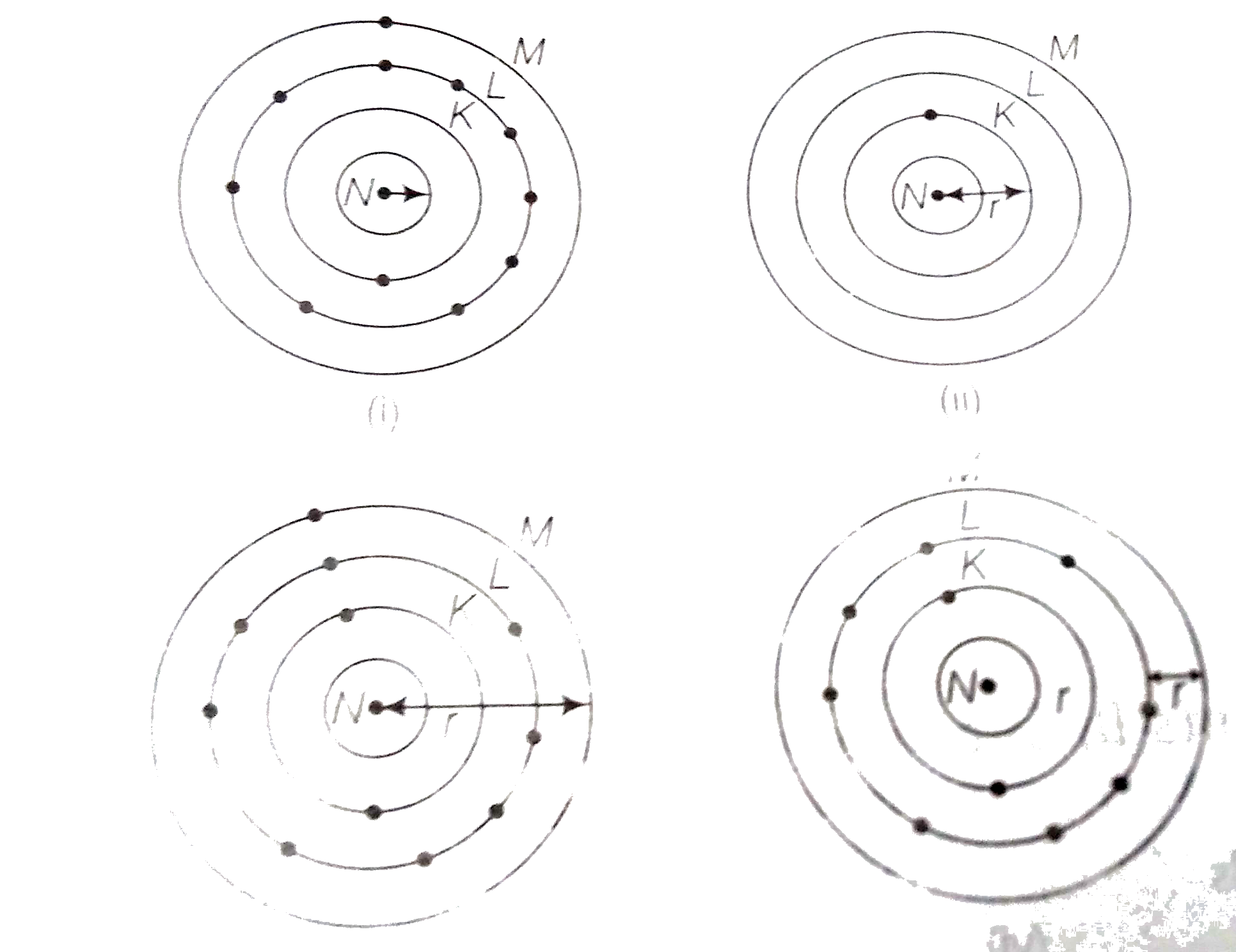
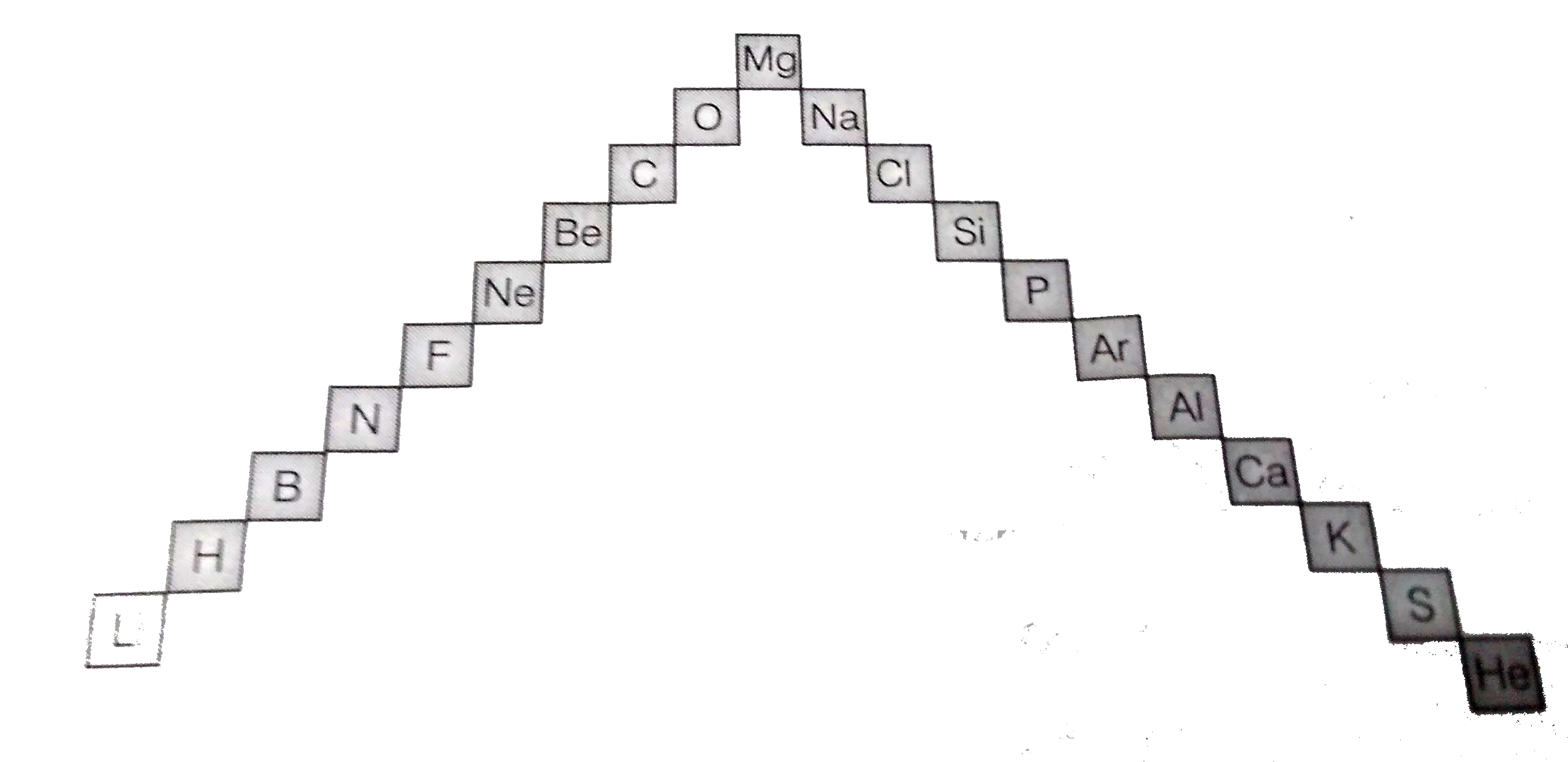 .
.